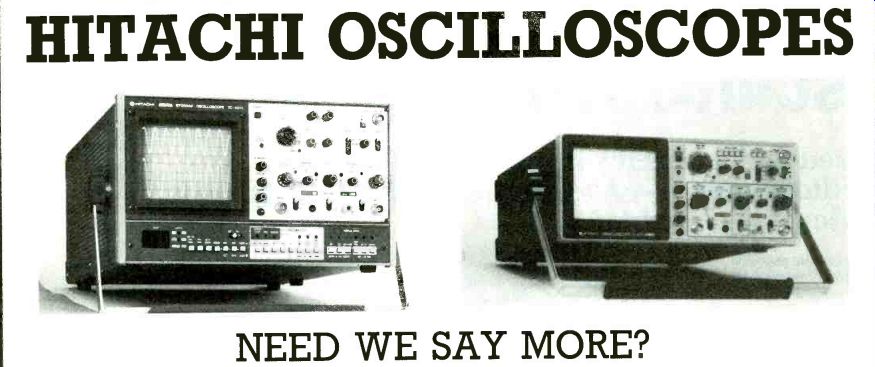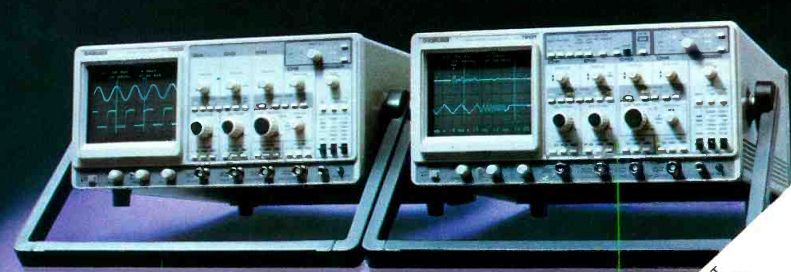Speed and accuracy improve slightly but oscilloscopes are much better at displaying difficult waveforms.
Over the past few years, oscilloscopes have become a little faster but their ability to display difficult waveforms has improved significantly. Accuracy has not improved greatly either, mainly because of limitations of the c.r.t.
Instead, there is now a greater emphasis on built-in measurement aids like voltage and frequency meters whose results are displayed on the c.r.t. Custom i.c’s and digital logic are not only used in digital storage oscilloscopes.
Some new oscilloscopes even have auto-ranging for both amplitude and timebase. This need not cost the earth either.
For example the Grundig M022 has automatic timebase selection and costs $425, which is not much more than a standard 20MHz instrument.
There are few single-channel oscilloscopes now and features like channel add and invert are standard. And, as expected, digital storage is becoming cheaper--Hameg and Farnell for example have d.s.o’s for under $1000. Digital storage oscilloscopes cannot yet replace conventional real-time instruments, but the time will no doubt come.

Hewlett Packard has stopped producing real-time oscilloscopes because d.s.o’s are better value for money. If component costs keep falling, this will soon apply to oscilloscopes in lower price ranges.
As you can see from our table, Scope-x has produced no new instruments, but we believe that the company is working on digital storage. If you are thinking of buying a low-cost digital storage oscilloscope it may be worth waiting to see what the company's next new product is.

-------------Storage oscilloscopes
Display
Despite the fact that custom l.s.i. circuits are being used in oscilloscopes, the c.r.t. still remains the best display device.
The main change in the display over the past few years is the addition of colour.
One method of adding colour is to place a fast l.c.d. filter in front of the c.r.t., as used by Tektronix. A method more suited to digital-storage oscilloscopes is to use a colour raster-scan c.r.t., as Hewlett Packard do in some of their new models. Once the waveform is digitized, it is just as easy to make raster-scan video signals from it as it is to turn it back to analogue form, given today's digital control i.cs.
And, theoretically at least, raster-scanning allows an unlimited colour range.
Another advantage of the raster-scan method is that it gives manufacturers a wide choice of component sources, which is not the case with l.c.d. filters.
One potential disadvantage is loss of resolution. Using an l.c.d. filter, resolution is that of the monochrome tube whereas with a colour c.r.t., resolution is governed by the number of dots on the tube. In practice though this is not a problem because the digital oscilloscopes using raster-scan c.r.ts allow zooming.
New facilities For c.c.tv and computer servicing, Crotech has produced a 30MHz dual-trace oscilloscope that is, surprisingly, claimed to be the first that can display composite 625-line video signals as pictures. This simple addition removes the need for a video monitor.
Multi channel monitoring is the specialty of the Data Check 1880 which displays up to fourteen channels in bar-graph form or displays the waveform of one of 28 channels. Using scanning for waveform monitoring removes the need for reconnecting probes.
For many applications though, the 1880's price of $5000 makes it less attractive than a few conventional real-time oscilloscopes with input multiplexers.
Both 488 and BBC computer interfaces are fitted to the Farnell 12MHz DTS12T, which is probably the cheapest digital-storage oscilloscope with computer interfacing. Software for bidirectional data transfer is supplied on floppy disc and an f.f.t./waveform analysis rom/disc package is $70. At $1195, the 12T brings computer waveform analysis within the reach of many educational users.
One example of oscilloscopes with built-in measurement devices mentioned earlier is the V1100A. This 100MHz real time instrument gives on-screen display of direct/ alternating voltage, decibel ratios, frequency, period, time delay and phase shift. All setting conditions and ground-reference information are also displayed on screen. An important advantage of having all this information displayed is that it is automatically included on any screen photographs taken.
----------Non-storage oscilloscopes
Most computer-controlled instruments have a facility to store and recall front panel settings, which allows frequently made measurements to be carried out quickly. Auto-ranging goes a step further.
The facility is not new but nor is it common. There were problems associated with setting for low duty cycle pulses but these are now being ironed out so the numbers of auto-ranging oscilloscopes should increase.
With oscilloscopes such as the new Tektronix 2445/2465 family, pressing one button sets signal level, period, duty cycle and trigger requirements. Bandwidth of these instruments ranges from 150350MHz and besides auto-ranging, they also allow up to 20 stored front-panel settings.
Add-ons
On the premises that dedicated f.f.t. analyzers are expensive and can be difficult to use and that microcomputer add-ons are slow and given spurious results, Data Acquisition has designed an f.f.t. add-on suitable for any two-channel oscilloscope with trigger input.
This two-channel analyzer, which also acts as a 50kHz sampling digital-storage unit, can send information through a serial link to a microcomputer for further analysis or to a printer.
As a fully anti-aliased analyzer, the adaptor's span is selectable from 0-20Hz or 020kHz with 100 or 200-line resolution and up to 256 averages can be taken. Scaling is either linear or logarithmic, with 40dB log span, and Nanning or rectangular weighting is switchable.
Cross-transfer function ability is possible using the oscilloscope’s signal add and invert facilities. The f.f.t./digital-storage adaptor will cost around $800. For readers with a real-time oscilloscope wanting faster digital storage there's a two-channel module made by Polar with 10MHz sampling per channel and a 2K-byte memory. An RS232 interface is now available for this unit which allows waveforms to be transferred directly to a computer so a real-time oscilloscope is not essential. The polar DS102 is $575, the RS232 interface is $50 and software for the IBM PC is $25. Resolution of the 102 is eight bits.
Bandwidth of Thurlby's eight-channel input multiplexer has been increased to 35MHz. Costing $179, the OM358 displays both digital and analogue signals and has a calibrated attenuator. Any channel can be used as the trigger source.
----------------------
Also see:
Component integration in oscilloscopes
Mains communication without tears
==========
(adapted from: Wireless World , Dec. 1986)